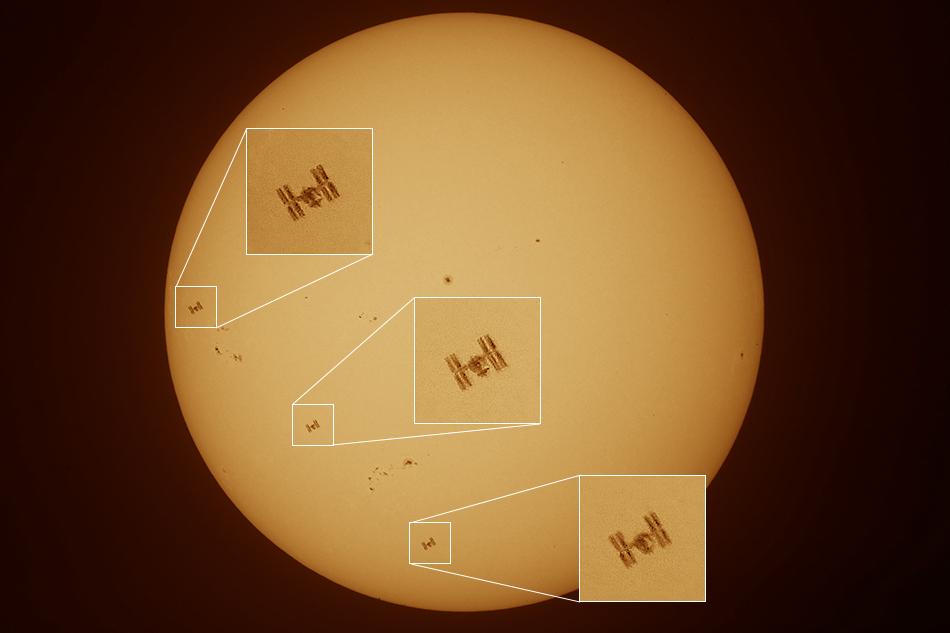
I have a particular interest in satellite transits across the solar/lunar surfaces due to the opportunity they present
the lucky observer to discern greater physical detail and structure as a result of their silhouette against the bright
background of the sun and/or moon; the ability to restrict the satellite's location in the daytime or evening sky to an
area measuring 0.5°x0.5° with little or no effort; it permits for the bypassing of satellite tracking which itself is a
challenge due the very short period transits are visible during a particular overhead pass; and the difficulty in
obtaining accurate and timely orbital elements and TLE's. As this "search and identify" project has literally become a
DAILY ritual, I expect this web page to be updated constantly with more and more images of the very unique phenomena of
satellite transits across the solar and/or lunar disks.
Note: The capture of a solar transit by the International Space Station was an incessant chase
for 3-4 years and until July 28, 2005 when the ISS (with
STS-114)
was finally captured transiting against the Sun and which included the space shuttle Discovery. Approximately nine months
later, the ISS was also caught transiting the rising moon (click
here) albeit at a very low altitude. My best ISS transit
capture occurred in 2018 when the ISS was at a range of 441.6 km away
transiting the Sun once again whereas in 2010 I was able to
also capture the ISS during the day transiting Jupiter at a
range of 439.5 km as well as Mars at a range of 565.9 km.
A stunning capture of the ISS transiting the Moon was captured 30 days earlier while traveling over the northernmost edge of
Mare Serenitatis (Sea of Tranquility) and continuing towards the Apennine Mountain region and the landing area of Apollo 15
and, finally, passing just to the west of the bright impact crater Aristarchus and at the easternmost edge of Mare Imbrium
(Sea of Rains) (see here). The Moon was
approximately one day past full and was characterized with a phase of 98.74%, a magnitude of -12.4 and an apparent diameter
of 33.72 arc-minutes while lying at a distance of 358,795 km away and which was very close to the minimum (perigee) distance
the Moon can attain during its elliptical orbit around Earth
(see here).
The result below but now involving the Sun has the ISS transiting the solar disk for 0.74 seconds while lying at a range of
551.4 km. The Sun has an angular diameter of 31.95 arc-minutes with Earth lying 149,790,972 km away and which represents the
midpoint between perihelion and aphelion
(see here).
Note: For a complete set of images captured so far involving satellite transits of both the Sun and Moon,
click here.
|
Satellite(s): Int Space Station USSPACECOM Cat No: 25544 (ISS) Physical Dimensions: 109.0 x 73.0 x 27.5m Orbit / Inclination: 351.3 x 355.1 km, 51.6° Range (Image): 551.4 km Angular Diameter: 50.1 " (ISS) Pass Details (ISS):
Launch Date (UTC):
|
 |
Date: Oct 01, 2023 13:52:54 UT+3 Location: Athens, Greece Equipment: AP 160 f/7.5 StarFire EDF AP 2x Convertible Barlow AP 1200GTO/CP3 GEM Canon EOS 6D Mark I Baader BCF2 Filter Baader UV/IR-Cut filter Baader ND-5 (full-aperture) Exposures: 3 x 1/4000 sec ISO 1250 RAW image format Custom White Balance Manual Mode Continuous Servo Mode Software: Digital Photo Pro V4.6.30.0 Photoshop CS6 Processing: RAW to TIFF (16-bit conv) Brightness/Contrast Unsharp Masking Resampling JPG Compression |